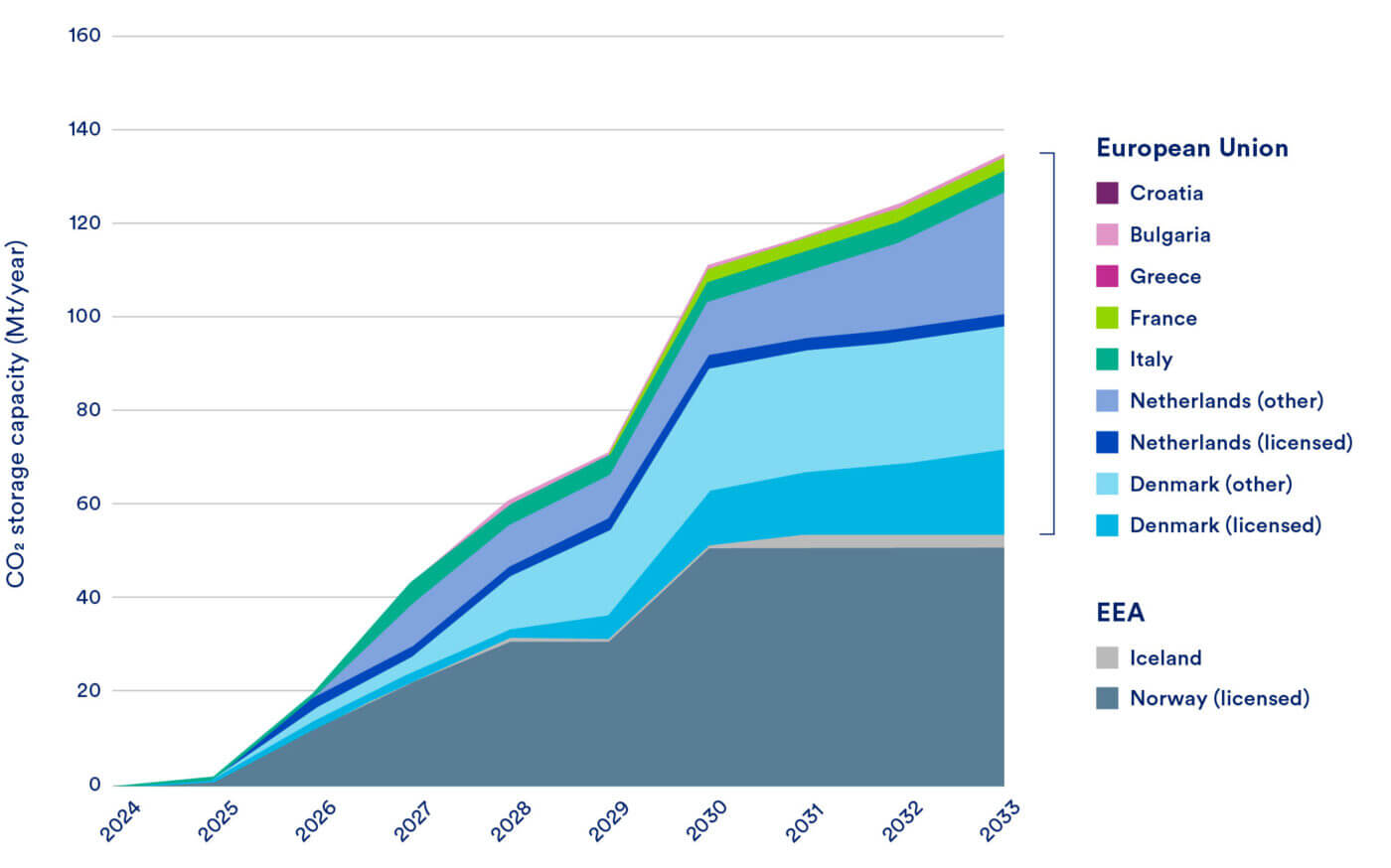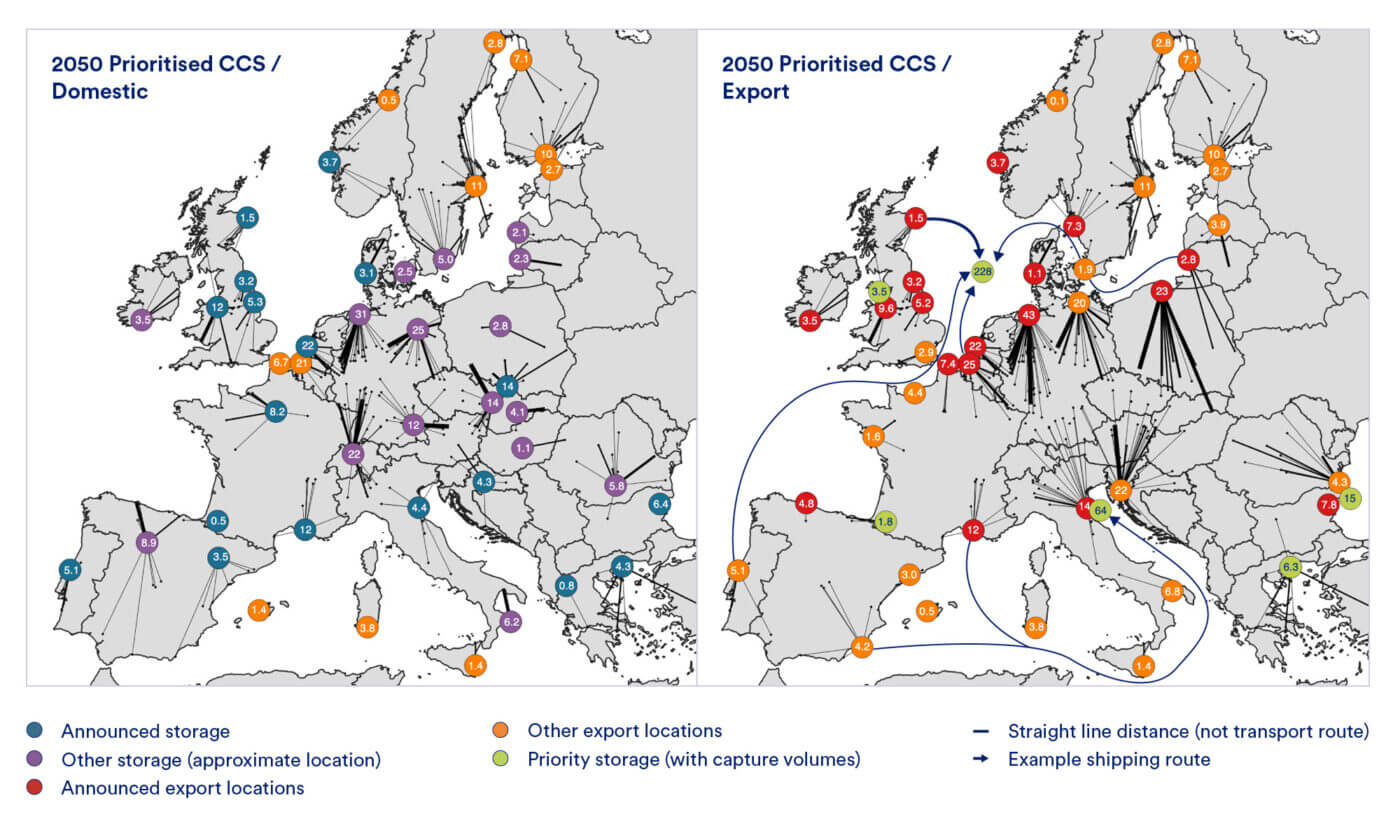
How the Net Zero Industry Act can create a European low-carbon industrial base through deploying carbon capture and storage
After a summer which saw record temperatures, wildfires and extreme weather across Europe, the need to accelerate climate action has never been more pronounced. At the same time, European industries face considerable challenges, as energy prices, higher interest rates and geopolitical tensions have created an uncertain future for key industrial sectors.
The need to advance cost-effective climate solutions which can rapidly reduce emissions has never been clearer. As has been outlined by all leading pathways to reach climate neutrality, including the European Commission, Intergovernmental Panel on Climate Change, the European Scientific Advisory Board on Climate Change and the International Energy Agency, 300 to 550 million tonnes of annual CO2 capture and storage capacity will need to be available by 2050 if Europe is to reach its climate goals.
Figure 1: The annual quantities of CO2 captured in Europe by 2050, according to decarbonisation scenarios modelled by the Commission (EU only), DNV, the IPCC, the IEA, and the European Scientific Advisory Board

In response to the Inflation Reduction Act (IRA), in March 2023, the European Commission proposed a Net Zero Industry Act (NZIA), which provides a promising framework for an options-based strategy to achieve industrial decarbonisation in Europe. As European policymakers on the EU and Member State level continue their negotiations on the proposal, we’ve taken a look at what it means for carbon capture and storage and what improvements can be made.
Here’s how the co-negotiators from the European Parliament and Council of the EU can strengthen the provisions of the NZIA to unblock this barrier in 5 ways:
- Set an ambitious storage capacity target
- Create an efficient CO2 market: An EU Carbon Capture and Storage Platform
- Ensure Member States lead the way on carbon capture
- Push producers to put CO2 back in the ground
- Rapidly accelerate the buildout of CO2 transport and storage infrastructure
1. Set an ambitious storage capacity target
The target set by the NZIA proposal to achieve an annual injection capacity of 50 million tonnes of CO2 per year in the EU by 2030 is the first of its kind and provides an important signal of recognition for carbon capture and storage as a critical tool to decarbonise Europe’s industrial sector. Moreover, the target provides an important North Star for EU carbon capture and storage policy development, including the various measures provided for by the NZIA. However, as Figure 1 shows, it represents a bare minimum of what needs to be deployed in the EU by 2030.
Reaching the 50 million ton target by 2030 will be a challenge, particularly as there are currently no operational CO2 storage sites in the EU and only one project has taken a final investment decision so far. Nevertheless, as Figure 2 shows, a pipeline of proposed projects is beginning to flow, showing ambition from industry to reach this target is achievable.
Figure 2: Annual injection capacity provided by currently proposed CO2 storage projects in the European Economic Area, showing those which have received exploration licenses

The NZIA CO2 storage target should therefore be the first of several steps to establishing a European carbon storage industry, fit to meet our climate needs. The forthcoming European Industrial Carbon Management Strategy should ensure that future milestone targets for operational injection capacity should also be introduced, which should take into account the scale of industrial emissions for 2035, 2040 and 2050 and updated plans for CO2 capture and storage demand.
2. Create an efficient CO2 market: An EU Carbon Capture and Storage Platform
While making CO2 storage capacity available by 2030 is critical, it is just as important that this capacity is efficiently used. As CATF’s project map shows, here is currently no shortage of available CO2 emissions to capture before 2030.
However, current capture project plans are largely limited to emitters with potential links to storage, and demand is likely to grow as more storage plans are made. At the same time, there is a need for new storage sites to have access to sufficient adequate captured volumes of CO2 and to ensure coordination between project developers. Storage projects that can contribute towards the target should therefore be required to demonstrate transport links to captured industrial emissions of at least equivalent magnitude – effectively constituting transport and storage hubs.
In order to ensure sources and sinks for captured CO2 can be efficiently matched, an aggregation platform for CO2 capture and storage is needed at the EU level. With this platform, any developer planning to capture or store CO2 could join, stating their planned volumes and timeline for CO2 capture or storage availability. This would create a point of contact for both ends of the CO2 value chain and become the pool from which the storage providers can identify and contract with CO2 providers.
Figure 3: An example of how an aggregation platform could work for carbon capture and storage

3. Ensure Member States lead the way on carbon capture
The ambition set by the NZIA to create an EU CO2 storage industry means that Member States must lead the way to realise this. As Figure 4 indicates, there is considerable interest in developing carbon capture and storage projects across Europe. However, knowledge gaps around the potential for geological storage exist in many Member States, meaning new analysis will be required to create an ‘EU CO2 storage atlas’. In this way, Member States would map the CO2 storage potential within their jurisdictions, applying a consistent methodology to the data made available and acquiring new sub-surface data where appropriate.
Figure 4: A map of planned CO2 infrastructure projects in the 6th list of PCI candidates for cross-border CO2 networks

As well as storage, developing cross-border CO2 networks will be critical to ensure European industries can decarbonise production processes with low additional cost to consumers. CO2 transport will require a combination of pipelines, shipping, rail, and road transport, with associated terminals and interchange infrastructure. This network must be planned and developed in parallel with the storage, or the EU will risk having stranded storage availability with inadequate means of bringing CO2 from the industrial sites.
To address this issue, the NZIA should integrate provisions to ensure Member States include in their report to the Commission: any planned CO2 transport infrastructure projects, the national measures supporting these projects and how the planned CO2 transport network will allow industries to access the storage they need. To ensure infrastructure projects can achieve financial viability, funding will be needed, which could come in the form of using national ETS revenues.
4. Push producers to put CO2 back in the ground
The oil and gas sector has the expertise, data, and assets to support the development of carbon capture and storage in Europe. With record-high profits from 2022, the industry has enough financial resources to provide sufficient CO2 storage capacity. Moreover, the European oil and gas sector has already called for a minimum storage ambition of 500 million tonnes per year by 2050, which would require at least 50 million tonnes per year by 2030 to remain realistically within reach. Article 18 in the NZIA proposal provides an important step by pushing producers in the EU to put CO2 back in the ground. However, ensuring this mechanism works effectively means creating the necessary conditions to do this.

Since EU oil and gas production areas do not necessarily correlate with areas where CO2 storage is most needed, or the most geologically promising areas for development, it is critical that this obligation reflect the needs of an emerging net-zero European industry, not those of producers obligated to store. Entities with greater obligations should be encouraged to work or reach agreements with partners in highly industrialised regions with less oil and gas production.
Obligated entities should also demonstrate that the means will be available to safely transport captured CO2 to the site, in volumes at least equal to the available injection capacity and in the required timeframe. In the event of delays, proof of appropriate progress towards realisation of the full value chain could take the form of final investment decisions for associated third-party infrastructure or capacity contracts with transport service operators. Additional time could be afforded in such cases, provided their contribution accounts for the shortfall accrued during such time. The NZIA should also include proportionate penalties and fines for the producers that do not meet their obligation, with those funds being used to help fund to develop the CO2 transport and storage network.
5. Rapidly accelerate the buildout of CO2 transport and storage infrastructure
In order to meet the 2030 storage capacity target, as well as our climate ambitions, it is critical that the NZIA provide the conditions to accelerate CO2 transport and storage infrastructure projects in the EU. The eligibility of CO2 storage facilities for Net Zero Strategic Project status and the permitting deadline of 18 months will help this and also increase competitiveness of European industries. However, the NZIA must also provide measures to accelerate Member State processes to grant exploration licences for CO2 storage, as these are critical to developing storage infrastructure.
As Figure 5, based on a CATF report, indicates, the current distribution of proposed CO2 storage sites is a key barrier to scaling carbon capture in Europe, which will lead to significant added costs for industrial decarbonisation. Furthermore, some CO2 capture projects may directly contribute to the viability of the storage site by providing relatively dependable initial volumes of CO2 to proposed storage sites and can help seed the development of a wider CO2 network, which is critical for more rural, industrial facilities. These ‘anchor’ projects should be within the scope of the CO2 storage project and therefore, also be able to apply for Net Zero Strategic Project status.
Figure 5: A European Carbon Capture and Storage Market

Propel European industry towards net-zero emissions with carbon capture and storage
As Europe faces the challenge of rapidly cutting its emissions and retaining its industrial base, the Net Zero Industry Act offers the opportunity to target both of these objectives. Carbon capture and storage can significantly cut emissions across many industrial sectors in Europe but faces a significant bottleneck in the slow development of storage sites.
While the NZIA proposal provides a number of excellent policy proposals, several key improvements should be made in order to maximise the opportunity of carbon capture and storage.





